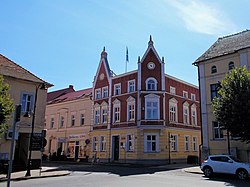Buk, Greater Poland Voivodeship
This article needs additional citations for verification. (June 2022) |
Buk | |
|---|---|
 Town hall | |
| Coordinates: 52°21′N 16°31′E / 52.350°N 16.517°E | |
| Country | |
| Voivodeship | Greater Poland |
| County | Poznań |
| Gmina | Buk |
| Town rights | 1289 |
| Government | |
| • Mayor | Paweł Adam |
| Area | |
| • Total | 2.96 km2 (1.14 sq mi) |
| Population (31 December 2021[1]) | |
| • Total | 5,903 |
| • Density | 2,000/km2 (5,200/sq mi) |
| Time zone | UTC+1 (CET) |
| • Summer (DST) | UTC+2 (CEST) |
| Postal code | 64-320 |
| Area code | +48 61 |
| Vehicle registration | PZ, POZ |
| Primary airport | Poznań–Ławica Airport |
| Voivodeship roads | |
| Website | www.buk.gmina.pl |
Buk [buk] is a town in Poznań County, in the Greater Poland Voivodeship, in central Poland. As of December 2021, the town has a population of 5,903.[1]
Etymology[edit]
The town's name means "Beech" in Polish, and the flag of the town shows a branch of beech, and three beech leaves. According to legend, Mieszko I, the first Christian ruler of Poland, died under a beech tree near the city.
History[edit]

Buk was granted town rights in 1289. It was a private church town, administratively located in the Poznań County in the Poznań Voivodeship in the Greater Poland Province of the Kingdom of Poland.[2]
Following the joint German-Soviet invasion of Poland, which started World War II in September 1939, Buk was occupied by Germany until 1945. On 10 October 1939, the Germans executed Polish parliamentarian Franciszek Górczak in Buk (see Nazi crimes against the Polish nation). In 1940, the occupiers carried out expulsions of Poles, who were deported to a transit camp in Łódź, while their houses and workshops were handed over to German colonists as part of the Lebensraum policy.[3] The Polish resistance was active in Buk. The Grey Ranks printed Polish underground press, conducted intelligence, organized secret Polish schooling and secret film screenings for young people, etc.[4] In 1943, the Germans renamed the town to Buchenstadt in attempt to erase traces of Polish origin. Tadeusz Wojtczak, founder of the local units of the Grey Ranks, was arrested by the Germans in August 1943, and following a brutal investigation he was imprisoned in the infamous Fort VII in Poznań[5] and eventually killed in the Gross-Rosen concentration camp. In January 1945, a German-perpetrated death march of prisoners of various nationalities from the dissolved camp in Żabikowo to the Sachsenhausen concentration camp passed through Buk.[6] In 1945, Polish partisans clashed with the Wehrmacht rear security near Buk.[7] After the war, Buk was restored to Poland, although with a Soviet-installed communist regime, which stayed in power until the Fall of Communism in the 1980s. Some members of the Polish resistance movement were persecuted by the communists after the war. In 1947, the communists arrested Henryk Blimel, leader of the local Lisy unit of the Grey Ranks, and sentenced him to 12 years in prison.[7]
From 1945 to 1998, Buk was administratively part of the Poznań Voivodeship.
Demographics[edit]
|
| |||||||||||||||||||||||||||||||||||||||
| Source: [8][9][10] | ||||||||||||||||||||||||||||||||||||||||
Transport[edit]
The Polish Voivodeship roads 306 and 307 pass through the town, and the A2 motorway runs nearby, north of the town. There is also a train station in Buk.
Major corporations[edit]
References[edit]
- ^ a b "Local Data Bank". Statistics Poland. Retrieved 2022-06-02. Data for territorial unit 3021034.
- ^ Atlas historyczny Polski. Wielkopolska w drugiej połowie XVI wieku. Część I. Mapy, plany (in Polish). Warszawa: Instytut Historii Polskiej Akademii Nauk. 2017. p. 1a.
- ^ Wardzyńska, Maria (2017). Wysiedlenia ludności polskiej z okupowanych ziem polskich włączonych do III Rzeszy w latach 1939-1945 (in Polish). Warszawa: IPN. p. 195. ISBN 978-83-8098-174-4.
- ^ Encyklopedia konspiracji Wielkopolskiej 1939–1945 (in Polish). Poznań: Instytut Zachodni. 1998. pp. 99, 416, 648. ISBN 83-85003-97-5.
- ^ Encyklopedia konspiracji Wielkopolskiej 1939–1945. p. 648.
- ^ "Ewakuacja piesza". Muzeum Martyrologiczne w Żabikowie (in Polish). Retrieved 26 November 2023.
- ^ a b Encyklopedia konspiracji Wielkopolskiej 1939–1945. p. 99.
- ^ Wiadomości Statystyczne Głównego Urzędu Statystycznego (in Polish). Vol. X. Warszawa: Główny Urząd Statystyczny. 1932. p. 199.
- ^ Dokumentacja Geograficzna (in Polish). Vol. 3/4. Warszawa: Instytut Geografii Polskiej Akademii Nauk. 1967. p. 5.
- ^ Stan i struktura ludności oraz ruch naturalny w przekroju terytorialnym w 2010 r. (PDF) (in Polish). Warszawa: Główny Urząd Statystyczny. 2011. p. 105. Archived from the original (PDF) on 13 November 2011.




